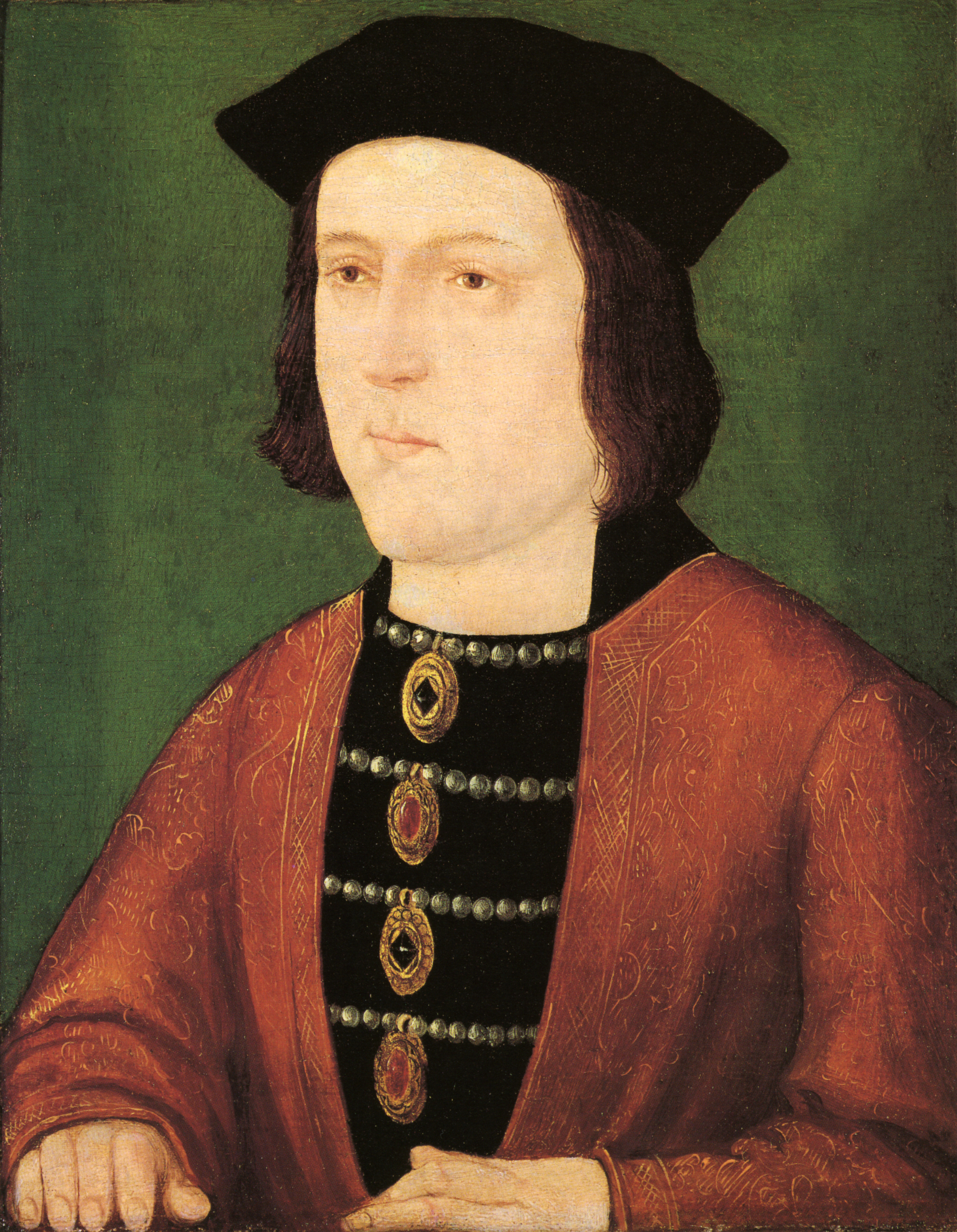
Edward IV
Edward IV (28 April 1442 – 9 April 1483) was King of England from 4 March 1461 to 3 October 1470,[1][2] then again from 11 April 1471 until his death in 1483. He was a central figure in the Wars of the Roses, a series of civil wars in England fought between the Yorkist and Lancastrian factions between 1455 and 1487.
For the play, see Edward IV (play).Edward IV
4 March 1461 – 3 October 1470
11 April 1471 – 9 April 1483
28 June 1461
9 April 1483 (aged 40)
Westminster, Middlesex, England
18 April 1483
Edward inherited the Yorkist claim to the throne at the age of eighteen when his father, Richard, Duke of York, was killed at the Battle of Wakefield in December 1460. After defeating Lancastrian armies at Mortimer’s Cross and Towton in early 1461, he deposed King Henry VI and took the throne. His marriage to Elizabeth Woodville in 1464 led to conflict with his chief advisor, Richard Neville, Earl of Warwick, known as the "Kingmaker". In 1470, a revolt led by Warwick and Edward's brother George, Duke of Clarence, briefly re-installed Henry VI. Edward fled to Flanders, where he gathered support and invaded England in March 1471; after victories at the battles of Barnet and Tewkesbury (where both the Earl of Warwick and Edward of Westminster, Prince of Wales, were killed), he resumed the throne. Shortly afterwards, Henry VI was found dead in the Tower of London, possibly killed on Edward's orders.
Despite facing an overseas threat from Henry Tudor, the last remaining Lancastrian claimant, Edward reigned in relative peace for the next twelve years. Edward nearly restarted the Hundred Years' War, following his invasion of France in 1475, but he was assuaged by Louis XI in the Treaty of Picquigny. This treaty formally ended the Hundred Years' War, which had been effectively over since 1453. Following his sudden death in April 1483, Edward was briefly succeeded by his son Edward V; his younger brother, Richard, was appointed Lord Protector of England, due to the new king's minority, but he quickly seized the throne as Richard III.
$_$_$DEEZ_NUTS#0__titleDEEZ_NUTS$_$_$
$_$_$DEEZ_NUTS#0__subtitleDEEZ_NUTS$_$_$
Birth and ancestry
Edward was born on 28 April 1442 at Rouen in Normandy, eldest surviving son of Richard, 3rd Duke of York, and Cecily Neville.[3] Until his father's death, he was known as the Earl of March.[4] Both his parents were direct descendants of King Edward III, giving Edward a potential claim to the throne. This was strengthened in 1447, when York became heir to the childless King Henry VI on the death of Humphrey, Duke of Gloucester.[5][a]
Allegations of illegitimacy were discounted at the time as politically inspired, and by later historians.[6][b] Edward and his siblings George, Duke of Clarence, and Margaret, Duchess of Burgundy, were physically very similar, all three being tall and blonde, in contrast to their father, the Duke of York, who was short and dark.[7] His youngest brother, who later became King Richard III, closely resembled their father.[8][c]
$_$_$DEEZ_NUTS#3__titleDEEZ_NUTS$_$_$
$_$_$DEEZ_NUTS#3__descriptionDEEZ_NUTS$_$_$
$_$_$DEEZ_NUTS#1__titleDEEZ_NUTS$_$_$
$_$_$DEEZ_NUTS#1__descriptionDEEZ_NUTS$_$_$
Edward had ten children by Elizabeth Woodville, seven of whom survived him; they were declared illegitimate under the 1484 Titulus Regius, an act repealed by Henry VII, who married Edward's eldest daughter, Elizabeth.[79]
Edward had numerous mistresses, including Lady Eleanor Talbot and Elizabeth Lucy, possibly daughter of Thomas Waite (or Wayte), of Southampton. The most famous was Jane Shore, later compelled by Richard III to perform public penance at Paul's Cross; Thomas More claimed this backfired, since "albeit she were out of al array save her kyrtle only: yet went she so fair & lovely … that her great shame wan her much praise."[81]
Edward had several acknowledged illegitimate children;
There are claims for many others, including Mary, second wife of Henry Harman of Ellam, and Isabel Mylbery (born circa 1470), who married John Tuchet, son of John Tuchet, 6th Baron Audley. However, the evidence for these is circumstantial.[86]
Aftermath
Edward IV's eldest son, also named Edward, was made Prince of Wales when he was seven months old and given his own household at the age of three. Based in Ludlow Castle, he was supervised by his uncle, Anthony Woodville, 2nd Earl Rivers, who also acted as his regent for the Council of Wales and the Marches.[87] The historical consensus is he and his brother Richard were killed, probably between July and September 1483; debate on who gave the orders, and why, continues, although their uncle Richard III was the beneficiary.[88]
By mid-August, Elizabeth Woodville was certain of the deaths of her sons; after her initial grief turned to fury, she opened secret talks with Margaret Beaufort. She promised her support in return for Henry's agreement to marry her eldest daughter Elizabeth.[8] In December 1483, Henry swore an oath to do so, which he duly carried out after his coronation in October 1485.[89]
Prior to his succession, Richard III declared his nephews illegitimate, on the grounds his brother's marriage to Elizabeth Woodville was invalid.[8] The Titulus Regius argued that since Edward had agreed to marry Lady Eleanor Talbot, his marriage to Elizabeth Woodville was void. Both Eleanor and Edward were dead, but Robert Stillington, Bishop of Bath and Wells, further claimed to have actually carried out the ceremony. Once secure on the throne Henry VII annulled the Titulus and arrested Stillington, since his marriage to Elizabeth's daughter added legitimacy to his claim; Stillington died in prison in 1491.[90]
Despite this apparent resolution, the Yorkist cause continued well into the 16th century. The most famous are the pretenders Lambert Simnel and Perkin Warbeck, but Yorkist challengers remained a concern for Henry VII and his son. In 1541, Henry VIII executed Margaret Pole, Countess of Salisbury, daughter of the Duke of Clarence, while a number of attempts were made on the life of her son, Cardinal Reginald Pole, who died in 1558.[91]
$_$_$DEEZ_NUTS#4__titleDEEZ_NUTS$_$_$
$_$_$DEEZ_NUTS#4__subtextDEEZ_NUTS$_$_$
$_$_$DEEZ_NUTS#2__titleDEEZ_NUTS$_$_$
$_$_$DEEZ_NUTS#2__subtextDEEZ_NUTS$_$_$
